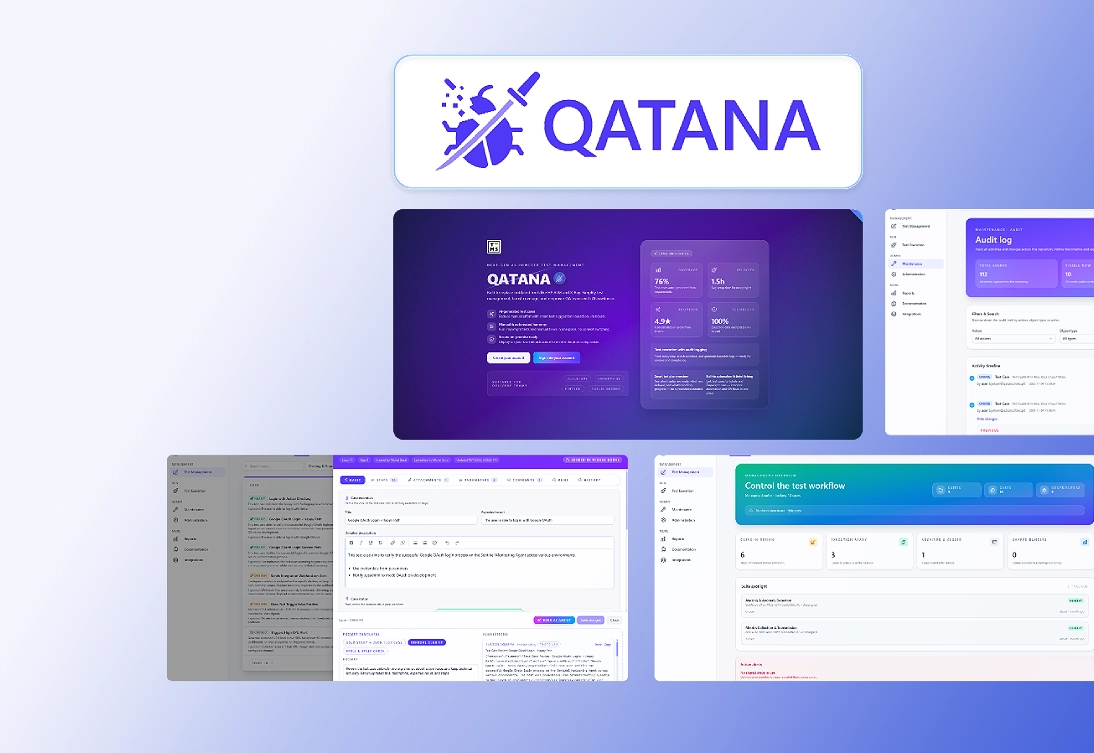Use artificial intelligence to increase the efficiency of your tools
Solve your problems with QATANA.
Writing test scenarios consumes a significant portion of your test team’s capacity. Based on our experience – you reduce the time consumption of your quality control by 30%, when utilizing AI assistance and other features offered by QATANA.
Key Features That Set Our AI Software Test Management Tool
AI-Assisted Test Intelligence
Automatically generates draft test cases and selects regression suites from ticket content and release notes — dramatically reducing repetitive manual work.
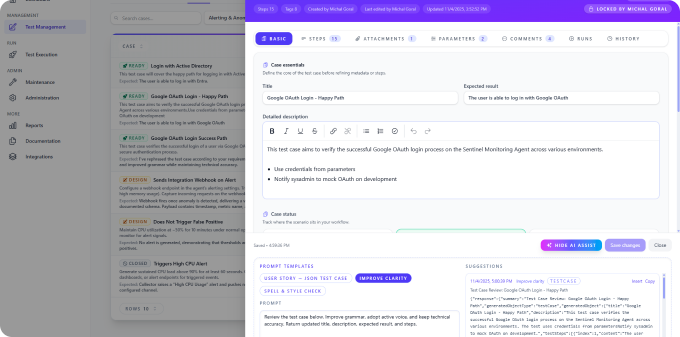
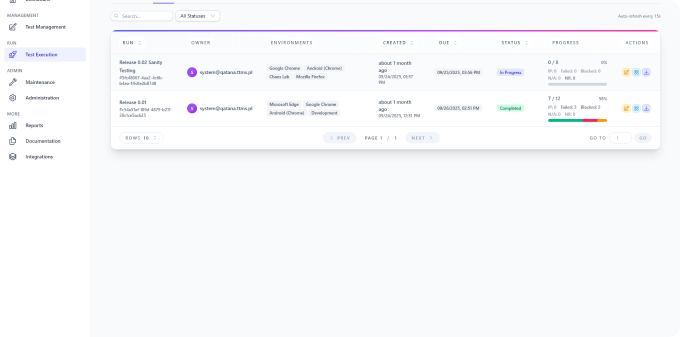
Full Test Lifecycle Management
Create, clone, edit and organize test cases with defect tracking through an integrated ticketing systems.
Hybrid Manual + Automated Workflows
Track manual execution alongside Playwright automation results in one unified view — no silos between manual QA and automation.
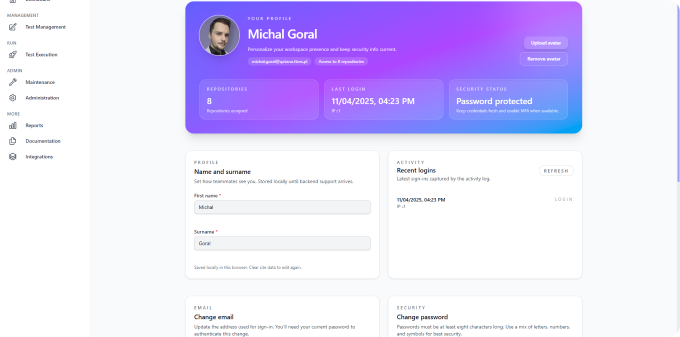

Real-time dashboards and custom reporting
Live dashboards offer a real-time overview of test execution progress, empowering teams with immediate insights. Custom reports let you shape the data your way — filter, visualize, and export exactly what matters.
Role-based Access & Audit-ready Logs
Fine-grained roles plus compliance-ready audit trails for regulated environments.
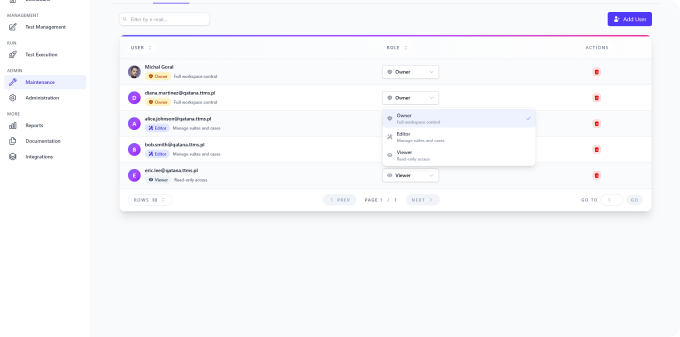
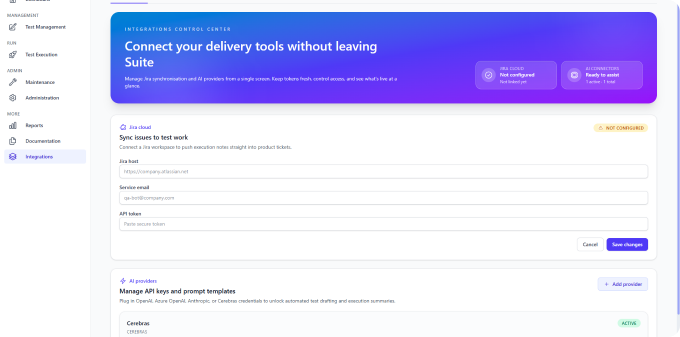
Flexible Integrations
Seamless integrations with Jira, Playwright, AI, and any ticketing system. Built for complex workflows. Bulk import/export makes onboarding effortless.
Secure On-Premise Deployment
Enterprise-grade option to deploy fully on your infrastructure for maximum data control and compliance.

What Problems Does QATANA Solve?
A Comprehensive Software Testing Solution
QATANA (our test management tool) tackles the everyday blockers that slow QA and releases:

Visibility & Traceability
Replace scattered spreadsheets and disconnected documents with a unified, intelligent testing platform linking Playwright, manual test cases and test results.

Manual Workload & Regression Selection
Boost productivity with AI-generated tests, intelligent case selection, and reusable test steps.

Siloed Manual vs Automated Testing
Hybrid workflows let teams run and review manual steps and automated Playwright results together, increasing test coverage and speed.

Compliance & Security Concerns
On-premise deployment and audit logs give regulated industries full control over sensitive test data and compliance reporting.

Slow Adoption & Tool Overhead
Intuitive UI, interactive tutorials and bulk import/export enable onboarding in days, not weeks — lowering change resistance.

Why Choose TTMS’s Test Management Solution
for Software Testing?
AI-Assisted Test Intelligence
QATANA integrates with the AI LLMs of your choice and that drafts tests and selects regression suites from ticketing data and release notes, reducing repetitive effort.
Flexible Integrations
Use QATANA standalone or integrate with Jira and other tools; flexible to your stack.
Fast Adoption, Minimal Setup
Intuitive UI + bulk import features speed up implementation and onboarding.
QA-Led by QA Engineers
Built by testers to match real workflows and pain points.
Cost-effective, Scalable Licensing
On-premise multi-user licensing that scales with your team size.
Built-in Tutorials
Embedded step-by-step guides and walkthroughs help new users quickly learn features and best practices without external training.
Which Industries Will Benefit from TMT Implementation?
Software & SaaS
Banking & Finance
Healthcare & Pharma
Automotive & Manufacturing
E-commerce & Retail
Public Sector & Education
How Does the Software Test Management System Implementation Process Look?
Map QA processes, tools, and compliance needs.
Install plugins and set up LLM connection.
Configure projects, assign roles and import existing test artifacts.
Versioning, enhancements and support aligned to your QA maturity.
Workshops for testers, leads and developers plus interactive tutorials.
Your Technology Partner
– Why Choose TTMS?
We are TTMS — a software and AI solutions partner with years of hands-on experience delivering practical, production-ready systems. Since 2015 we’ve helped organisations modernise processes, integrate intelligent automation and ship secure, maintainable software across regulated and fast-moving industries.
Our teams combine product engineering, AI expertise and consultative delivery so we can run engagements from staff augmentation to full end-to-end delivery. We prioritise fast adoption, low-friction integrations and long-term support so your solutions deliver measurable value from day one.
Want to explore QATANA on your infrastructure? Contact us to schedule a demo or request an on-premise licensing proposal.
Ready to take your business to the next level?
Let’s talk about how TTMS can help.

Krzysztof Stachowiak
Head of AEM
FAQ
What is a test management tool in software testing?
A test management tool centralises test cases, execution runs, defects and traceability so teams can plan, execute and report testing across releases. Modern test management tools — including AI-capable platforms — add dashboards, traceability matrices and role-based controls to improve visibility and compliance.
What is test management in software testing?
Test management is the practice of organising testing activities (requirements mapping, test design, execution, defect tracking and reporting) to ensure consistent test coverage and measurable product quality. Effective test management shortens feedback loops and helps teams prioritise test effort based on risk and release needs.
Which tool is used for test management?
Teams use a range of tools (open source and commercial) depending on process maturity and integration needs. Look for solutions that support full lifecycle management, reporting, and CI/automation integrations — and, where required, on-premise deployment for stronger data control. Tools that incorporate AI-assisted test generation can reduce manual test design and speed regression selection.
What is the role of software test management?
The role of software test management is to provide traceability, visibility and control over testing so stakeholders can assess release readiness, meet compliance requirements and make data-driven decisions about quality. Test management ties requirements to test outcomes, surfaces coverage gaps and helps teams optimize test effort for faster, safer releases.
